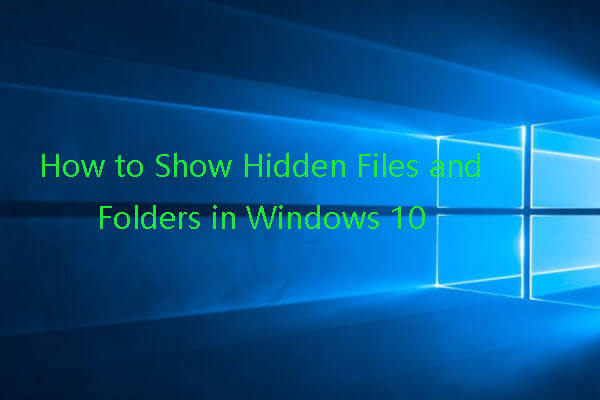This post introduces some popular Windows Shell commands to allow you to open specific Windows system folders on Windows 10. Aside from offering various computer tips and solutions, MiniTool software also releases many useful tools for users, incl. MiniTool Power Data Recovery, MiniTool Partition Manager, MiniTool ShadowMaker, and more.
By using Windows Shell commands, you can open specific system folders on your Windows 10 computer.
Many hidden system folders in Windows are recorded in Windows Registry and have the class ID (CLSID) key, special folder name and the folder location. The CLSID keys allows Windows OS and other programs to easily identify the system folder without knowing the real name of the folder.
You can use the Windows Shell command with along with the specific folder to open hidden system folders in your Windows 10 OS.
Find Windows Shell Objects You Can Work With in Registry
There are many system folders you can open by using Windows 10 Shell commands. You can check the list of Windows Shell objects in Windows Registry by following the steps below.
Step 1. Open Registry Editor on Windows 10.
You can press Windows + R, type regedit in Run dialog, and press Enter to access Windows Registry window.
Step 2. Navigate to the following path in Registry.
HKEY_LOCAL_MACHINE\SOFTWARE\Microsoft\Windows\CurrentVersion\Explorer\FolderDescriptions
Step 3. Check the folders CLSID and location.
Under FolderDescriptions key, you can click each subkey that represents a specific folder. The name of the key is the CLSID of that folder.
In the right window, you can check the Name value data and it is the common name of the folder. You can also check the RelativePath value data and it is the actual path of the folder location.
How to Use Windows Shell Command to Open System Folders
After you know the special folder name and folder location by following the instructions above, you can use Windows Shell commands to open even hidden system folders.
Step 1. Open Windows Run dialog.
You can press Windows + R at the same time to open Windows Run dialog. You can execute the Shell command in Window Run dialog box. You can also run Shell command in Windows File Explorer address bar.
Step 2. Run Windows Shell Command to open hidden system folders.
Then you can type shell:<foldername> command in Run dialog, and press Enter to open special hidden system folders. Replace “foldername” with the exact name of the folder.

List of Folder Names You Can Use after Windows Shell Command
Below is the list of popular folder names you can use after the Windows Shell command, as well as the relative locations of the folders.
1. shell:AccountPictures – %AppData%\Microsoft\Windows\AccountPictures
This command lets you easily access the account pictures folder on your Windows 10 computer.
2. shell:Administrative Tools – %AppData%\Microsoft\Windows\Start Menu\Programs\Administrative Tools
This command allows you to access Administrative Tools folder.
3. shell:AppData – %AppData%
Access AppData folder in your Windows 10 OS.
4. shell:Application Shortcuts – %LocalAppData%\Microsoft\Windows\Application Shortcuts
Open Application shortcuts folder.
5. shell:AppsFolder – Applications
Open Apps folder.
6. shell:AppUpdatesFolder – Installed Updates
Open the Apps updates folder.
7. shell:Cache – %LocalAppData%\Microsoft\Windows\INetCache
Open the Cache folder.
8. shell:Camera Roll – %UserProfile%\Pictures\Camera Roll
Open camera roll folder.
9. shell:CD Burning – %LocalAppData%\Microsoft\Windows\Burn\Burn
Access the temporary burn folder.
10. shell:Common AppData – %ProgramData%
Open the Common AppData folder.
11. shell:Common Desktop – %Public%\Desktop
Access Public Desktop folder.
12. shell:desktop – Desktop
Open the Desktop folder.
13. shell:Common Documents – %Public%\Documents
Open Public Documents folder.
14. shell:CommonPictures – %Public%\Pictures
Access Pictures folder.
15. shell:Cookies – %LocalAppData%\Microsoft\Windows\INetCookies
Open Cookies folder.
16. shell:documentsLibrary – Libraries\Documents
Open Documents Library folder.
17. shell:downloads – %UserProfile%\Downloads
Open Downloads folder.
18. shell:History – %LocalAppData%\Microsoft\Windows\History
Open the History folder.
19. shell:My Music – %UserProfile%\Music
Access My Music folder.
20. shell:ProgramFiles – %ProgramFiles%
Open ProgramFiles folder.
For the complete list of Shell commands in Windows 10, you can check: Complete List of All Windows 10 Shell Commands.
Bottom Line
You can follow the detailed instructions above to open hidden system folders with Windows Shell Commands. To recover lost or deleted files on Windows 10, MiniTool Power Data Recovery helps you easily achieve it.


User Comments :